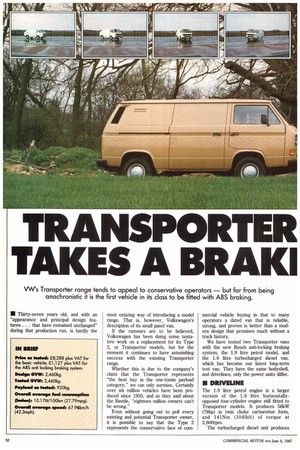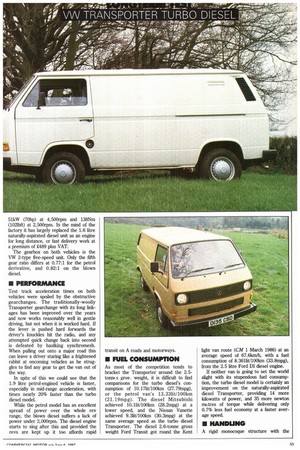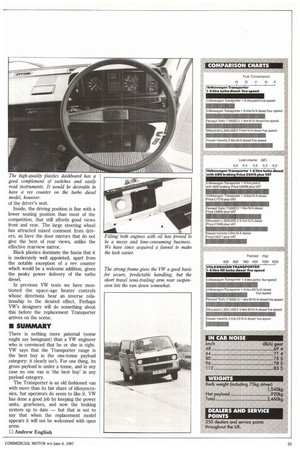TRANSPORTER TAKES A BRAKI
Page 54

Page 55

Page 56

Page 57

If you've noticed an error in this article please click here to report it so we can fix it.
• Thirty-seven years old, and with an "appearance and principal design features. . that have remained unchanged" during that production run, is hardly the most enticing way of introducing a model range. That is, however, Volkswagen's description of its small panel van.
If the rumours are to be believed, Volkswagen has been doing some tentative work on a replacement for its Type 2, or Transporter models, but for the moment it continues to have astonishing success with the existing Transporter range.
Whether this is due to the company's claim that the Transporter represents "the best buy in the one-torme payload category," we can only surmise. Certainly over six million vehicles have been produced since 1950, and as they said about the Beetle, "eighteen million owners can't be wrong."
Even without going out to poll every existing and potential Transporter owner, it is possible to say that the Type 2 represents the conservative face of corn mercial vehicle buying in that to many operators a dated van that is reliable, strong, and proven is better than a modem design that promises much without a track history.
We have tested two Transporter vans with the new Bosch anti-locking braking system; the 1.9 litre petrol model, and the 1.6 litre turbocharged diesel van, which has become our latest long-term test van. They have the same bodyshell, and drivelines; only the power units differ.
• DRIVELINE
The 1.9 litre petrol engine is a larger version of the 1.6 litre horizontally. opposed four-cylinder engine still fitted to Transporter models. It produces 58kW (78bp) in twin choke carburettor form, and 141Nm (1041bft) of torque at 2,60Orpm.
The turbocharged diesel unit produces 51kW (70hp) at 4,500rpm and 138Nm (1021ft) at 2,500rpm. In the mind of the factory it has largely replaced the 1.6 litre naturally-aspirated diesel unit as an engine for long distance, or fast delivery work at a premium of £489 plus VAT.
The gearbox on both vehicles is the VW 2-type five-speed unit. Only the fifth gear ratio differs at 0.77:1 for the petrol derivative, and 0.82:1 on the blown diesel.
• PERFORMANCE
Test track acceleration times on both vehicles were spoiled by the obstructive gearchanges. The traditionally-woolly Transporter gearchange with its long linkages has been improved over the years and now works reasonably well in gentle driving, but not when it is worked hard. If the lever is pushed hard forwards the driver's knuckles hit the radio, and any attempted quick change back into second is defeated by baulking synchromesh. When pulling out onto a major road this can leave a driver staring like a frightened rabbit at oncoming vehicles as he struggles to find any gear to get the van out of the way.
In spite of this we could see that the 1.9 litre petrol-engined vehicle is faster, especially in mid-range acceleration, with times nearly 20% faster than the turbo diesel model While the petrol model has an excellent spread of power over the whole rev range, the blown diesel suffers a lack of power under 2,000rpm. The diesel engine starts to sing after this and provided the revs are kept up it too affords rapid
• FUEL CONSUMPTION
As most of the competition tends to bracket the Transporter around the 2.5tonncs gros% weight, it is difficult to find comparisons for the turbo diesel's consumption of 10.17lit/100km (27.79mpg), or the petrol van's 13.331A/100km (21.19mpg). The diesel Mitsubishi achieved 10.1lit/100km (28.2mpg) at a lower speed, and the Nissan Vanette achieved 9.3lit/100km (30.3mpg) at the same average speed as the turbo diesel Transporter. The diesel 2.6-tonne gross weight Ford Transit got round the Kent light van route (CM 1 March 1986) at an average speed of 67.6km/h, with a fuel consumption of 8.3611k/100km (33.8mpg), from the 2.5 litre Ford DI diesel engine.
If neither van is going to set the world alight with its stupendous fuel consumption, the turbo diesel model is certainly an improvement on the naturally-aspirated diesel Transporter, providing 14 more kilowatts of power, and 35 more newton metres of torque while delivering only 0.7% less fuel economy at a faster average speed.
• HANDLING
A riffid monocoque structure with the strength of the Transporter's is a good basis on which to build a suspension system with safe, predictable handling in the laden and unladen condition.
The Transporter's coil sprung independent wishbone front, and semi-trailing arm independent rear with telescopic damping achieves this only in part.
Part of the problem is the rear-mounted engine that enthusiastically lends its not inconsiderable weight to the oversteering, or tail-out tendency. The rear semitrailing arms further compound this with changes to the camber of the rear wheels in response to suspension movements.
In normal urban driving this is not too much of a problem once the driver has become used to the vehicle's peculiarities, but a witness to our laden progress round the Motor Industry Research Association's ride and handling circuit observed, "that van spends more time with its legs in the air than a dying ant."
The cab-over style of the Transporter is also taking some getting used to by some members of Commercial Motor's staff. This is because with the driver so far forward it is all too easy to make steering movements sooner than they need to be, resulting in some scuffed tyres against the kerbs.
• BRAKING
The anti-locking braking equipment used on the VW is a Bosch ABS system that began life in 1971 as a joint venture between VW and Teldix, and has since been developed by VW and Bosch.
All four wheels are monitored for deceleration (four-sensor), while modulation of the brakeline pressure takes place independently on the front wheels, and the rear axle as a whole (three-channel). The electric-powered pump and ABS system are mounted under the passenger seat with a failsafe device that ensures that normal braking is retained even if the ABS system fails.
Noise and pedal feel on anti-locking braking systems are at the discretion of the designers. Since the brake pedal is isolated from the main braking 'circuit when the system is energised pedal feel has to be contrived, while noise levels from the system depend on the siting of the unit and the insulation.
When the brake pedal is pressed hard enough to allow any wheel to approach locking the pedal starts to vibrate as cadence braking occurs, accompanied by a high pitched buzzing noise reminiscent of an 00 gauge Hornby train's electric motor fusing out. Once the boyhood model railway enthusiasts on the staff had become accustomed to the sound they pronounced the system to be very good, stopping the vehicle quickly with little sideways pull.
When the ABS is disconnected the vehicle still pulls up in a straight line but the front wheels lock, so braking distances are longer. When we tried simple cadence braking manually without the ABS engaged we could only achieve peak deceleration of around 0.77g with a much lower average, while the ABS system consistently maintained a far higher figure.
On the dry test track the manual cadence braking stopping distances were comparable with the ABS system's. This is to be expected as the ABS system will be continually retreating from a peak deceleration figure where the wheels are about to lock. In theory manual braking at a peak deceleration figure can give a smaller stopping distance than with ABS, although it is virtually impossible to achieve, even with a skilled driver on the best road surfaces.
In short, the Bosch ABS system, like most anti-locking systems that we have tried recently, will stop the vehicle effectively on most surfaces with control remaining firmly in the hands of the driver.
• INTERIOR
The cab-over style of the Transporter means that access and egress is tricky as the driver has to climb over the wheelarch to get to the seat, making it all too easy to polish the dirt off the side of the van with one's trousers when climbing out The high-quality plastics dashboard has a good complement of switches and easily read instruments. It would be desirable to have a rev counter on the turbo diesel model, however.
of the driver's seat.
Inside, the driving position is fine with a lower seating position than most of the competition, that still affords good views front and rear. The large steering wheel has attracted mixed comment from drivers, as have the door mirrors that do not give the best of rear views, unlike the effective rearview mirror.
Black plastics dominate the fascia that it is moderately well appointed, apart from the notable exception of a rev counter which would be a welcome addition, given the peaky power delivery of the turbo diesel.
In previous VW tests we have mentioned the space-age heater controls whose directions bear an inverse relationship to the desired effect. Perhaps VW's designers will do something about this before the replacement Transporter arrives on the scene.
• SUMMARY
There is nothing more paternal (some might say benignant) than a VW engineer who is convinced that he or she is right. VW says that the Transporter range is the best buy in the one-tonne payload category: it clearly isn't. For one thing, its gross payload is under a tonne, and in any case no one van is 'the best buy' in any payload category.
The Transporter is an old fashioned van with more than its fair share of idiosyncrasies, but operators do seem to like it. VW has done a good job by keeping the power units, gearboxes, and now the braking system up to date — but that is not to say that when the replacement model appears it will not be welcomed with open arms.




































































































